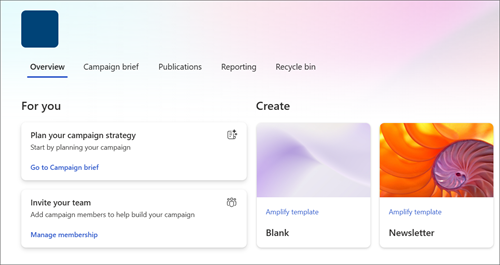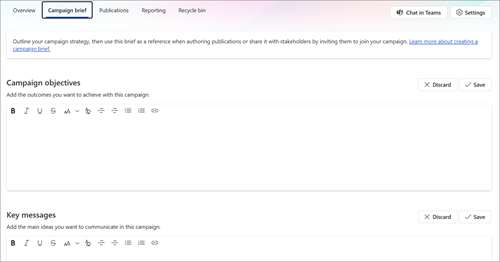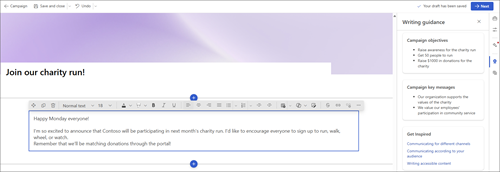Build a campaign brief in Microsoft Viva Amplify
Building a campaign brief helps establish the basic guidelines of your campaign. The brief is a durable asset that acts as a reference for anyone to get up to speed quickly on what the campaign is about while immersing everyone in the campaign’s core priorities to creates a culture of engaged campaign members focused on achieving a common goal. The brief is where the campaign objectives and key messages come together in one central place, enabling campaign managers to communicate what they hope to achieve. Briefs are also equally important internally to help corporate communicators gain alignment across different stakeholders and establish the purpose and scope of a campaign. You can view pre-filled objectives and key messages in the Pre-built campaigns.
Campaign briefs contain two main sections:
Tip: The campaign brief is intended to be a living document that guides and complements the work of the campaign team as they build the campaign. Make sure to keep the brief up to date as the campaign progresses. To share your campaign brief with others, simply invite them to the campaign.
When should I use a campaign brief?
When you get a new idea for a campaign, it can be tempting to charge ahead without laying down the foundation first. However, building a campaign requires a clear plan and defined objectives before the work begins. Use the Viva Amplify campaign brief template as a starting point when you want to take a proactive and structured approach when building your campaign to achieve your desired outcome. A campaign brief should help guide your thought process as you map out what your campaign will look like, who the campaign is for, and what success will look like. It is also recommended to create a brief if you’re building a large campaign or are working with multiple stakeholders.
Set Objectives and Key messages
-
Create a Microsoft Viva Amplify Campaign.
-
On the campaign landing page, select the Campaign brief tab located on the navigation bar or select the Campaign brief action card to get started.

-
Compose your objective(s) in the blank canvas provided. Add one or more campaign objectives as needed. Objectives are the first components of a campaign strategy that describe the main outcome(s) you want your campaign to achieve for your organization.

Objective details typically include a title and a description.
Examples of campaign objectives
-
Raise $100,000 for a specific charity
-
Increase employee participation by 30% for a specific volunteering event
-
Build awareness for an upcoming product launch
-
-
Once you've filled out the campaign objectives, save your changes. You can also choose to discard any changes as needed.
-
To make more changes, select Edit to open the canvas in edit mode. Make sure to save your changes.
-
Compose your key message(s) in the blank canvas provided. A key message is the main idea a communicator wishes to spread through a campaign. It serves as a guideline for what a communicator wants their stakeholder group or audience to hear, understand, and remember. A key message can also ask the audience to take specific actions. Key messages typically include
-
Title of the key message
-
Description
-
Tone
-
An overview of the audience this key message is targeted towards
Note: If you have multiple audiences, ensure you tailor your key message to each individual group.
-
-
Once you've filled out key messages, save your changes. You can also choose to discard your changes as needed.
-
For any additional changes, select Edit to to open the canvas in edit mode. Make sure to save your changes.
Formatting an objective or key message in the campaign brief
You have several options for objectives and key messages.
As soon as you land on the campaign brief template and start composing your campaign objectives and key messages, formatting options will be available to you. In this expanded view, select the text you want to format, then choose to bold, underline, italicize, or strikethrough the text.
Additional formatting options support bulleted or numbered lists and adding an external or internal link.
Campaign goals
Campaign goals are essential for a successful campaign. Goals provide direction and purpose for the campaign team, creating a unified understanding of what the campaign aims to achieve. Having well-defined goals allows you to measure the success of your efforts. By setting specific targets, you can track progress and determine whether the campaign is meeting its objectives for all distribution channels. Campaign goals empower you to make informed decisions and adjustments as needed throughout the campaign.
Currently, Viva Amplify supports goal tracking for the Unique viewers reporting signal. Learn more about reporting signals.
|
Signal |
Definition |
|---|---|
|
Unique viewers |
The number of people who have opened a publication in a campaign. |
Set and manage your Campaign goal
-
Navigate to the Campaign brief to set your campaign goal.
-
Enter a numerical value between 1 and 99.9 to represent the percentage of possible unique viewers you want your campaign to reach.
Note: Viva Amplify doesn't support goals of 100% to maintain user privacy.
-
Select the checkmark to save your changes and start tracking progress towards your goal.

-
When a goal is set, it applies to each distribution channel. For example, an overall goal of 50% for a campaign means that all distribution channels' goals are set to 50%. All distribution channels must therefore reach at least 50% of unique viewers in order for the overall goal to be reached.
Note: When at least one campaign publication is published to an entire organization, through either a public SharePoint site or a Viva Engage storyline, the goal progress tracker will remain blank until the percentage of unique viewers reaches 5%.
-
To view more details about the progress towards your goal, select View details in reporting to navigate to the Reporting tab for more insights.
Note: The campaign goal measures and tracks the goal for all the publications in your campaign. This means that if a goal is set to 50%, this will apply to all the publications within the campaign and their respective unique audiences regardless of the channels selected. For example, if a campaign contained three publications, each of which was sent to six people, there would be 18 possible views for your campaign. Goals per publication are not yet supported.
Writing guidance
Once your campaign brief has been saved, your campaign members can use it as a reference when writing their campaign publications. The campaign objectives and key message will display in the authoring writing guidance panel. This panel will help authors stay focused on the campaign goals and tailor the content to effectively achieve these aims.










